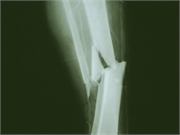Findings based on 12-month functional outcomes for surgery compared with functional bracing
WEDNESDAY, May 27, 2020 (HealthDay News) — Internal fixation surgery to treat closed humeral shaft fracture does not significantly improve 12-month outcomes versus nonoperative functional bracing, according to a study published in the May 12 issue of the Journal of the American Medical Association.
Lasse Rämö, M.D., from the University of Helsinki, and colleagues randomly assigned 82 adult patients (mean age, 48.9 years; 46 percent women) with closed, unilateral, displaced humeral shaft fractures to either surgical treatment with open reduction and internal plate fixation (38 patients) or nonsurgical treatment with functional bracing (44 patients).
The researchers found that 30 percent of the patients assigned to functional bracing underwent surgery during the 12-month follow-up period to promote healing of the fracture. The mean Disabilities of Arm, Shoulder and Hand score at 12 months was 8.9 in the surgery group versus 12.0 in the bracing group (between-group difference, −3.1 points; 95 percent confidence interval, −9.6 to 3.3; P = 0.34). One-quarter of patients randomly assigned to functional bracing developed fracture nonunion. Additionally, 8 percent of patients allocated to surgery developed a temporary radial nerve palsy.
“The findings provide useful information to doctors treating humeral shaft fractures, as they explain to patients the expected outcomes of different treatment forms as well as their associated risks,” Rämö said in a statement.
Copyright © 2020 HealthDay. All rights reserved.








